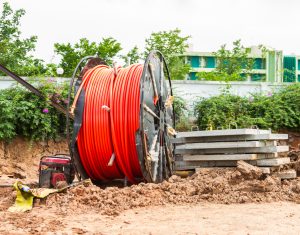Comparing 5G and Fiber Optic Internet
Fiber optic internet and 5G are the latest editions in connectivity. Where fiber optic internet uses a wired connection, 5G is wireless. Each type of connectivity offers benefits and challenges. This article will explore and compare 5G vs. fiber optic internet.
What Is 5G Internet?
Modern 5G — or fifth-generation — broadband is the latest advancement in cellular network technology. The 5G network ranges from 600 megahertz to 54 gigahertz across a low, middle and high band. In comparison, the old 4G LTE network’s range spanned 600 megahertz-900 megahertz.
Perks of 5G Internet
Using 5G internet service has several advantages, including:
- Speed: 5G offers download speeds up to 20 times faster than 4G LTE.
- Capacity: 5G’s bandwidth can support up to 1 million devices per square kilometer.
- Latency: 5G decreases the time it takes for a message to travel from sender to receiver.
- Energy efficiency: 5G is up to 90% more energy efficient per traffic unit than 4G LTE.
Drawbacks of 5G Internet
Logistical and financial challenges stand between the general public and 5G’s benefits, as using it requires updating the existing wireless telecommunications infrastructure.
Areas with 5G internet feature base stations that use antennae to pick up radio signals. These signals connect the cells to the internet and telephone network.
While shortening the wavelength increases speed and capacity, it limits the signal’s reach.
Existing 4G LTE towers are too far apart to handle 5G’s short radio signals. The signals will lose strength or hit interference before reaching the next tower.
Cellular providers must update the existing radio access network (RAN), which needs thousands of small cells in a given area to extend the 5G signal and route it around structures. Installation costs around $10,000 per unit.
Common 5G Internet Use Cases
The speed and capacity that 5G yields make it useful in many situations. For instance, 5G will enable new functions like machine-to-machine (M2M) communication. M2M communication will connect millions of industrial devices to the Internet of Things (IoT). Additionally, 5G will unlock new possibilities for the general public, such as:
- Remote medical treatment
- Remote education improvements
- Automated transportation
- Smart cities
What Is Fiber Optic Internet?
Fiber optic internet is a broadband system that transmits data through cables as light. Like 5G, fiber optic internet is a new connectivity advancement. While copper was once the standard for wired transmission, fiber optic cables feature bundles of thin glass strands instead. A terminal at the receiving end of the cable transmits the light into electrical signals.
A reflective cladding inside the cable contains the light, and optical amplifiers boost the signal.
Contact Our Team Of Experts Today
Perks of Fiber Internet
Fiber internet offers the following advantages:
- Speed: Fiber internet is up to 100 times faster than traditional broadband internet. The ceiling rises to 1,000 megabits per second for upload and download speeds alike.
- Bandwidth: Fiber internet has unlimited bandwidth. Users can connect as many devices as their router allows.
Drawbacks of Fiber Internet
Installing fiber optics internet cables can be challenging because wired connections must cross the last mile — the stretch of cable that runs from the main line into the user’s home.
Establishing efficient last-mile connections takes creativity. There are three common last-mile solutions — fiber to the premise (FTTP), fiber to the neighborhood (FTTN) or fiber to the building (FTTB). Each method comes with compromises. Fiber optic internet is often:
- Expensive to install because each endpoint requires new infrastructure.
- Slower than intended because the signal travels a great distance and splits to numerous users.
- Unavailable in certain areas due to the previous two factors.
Common Fiber Internet Use Cases
Fiber optics internet offers advantages that touch users in both commercial and residential settings. The benefits largely benefit from the speed that fiber optics enables.
Businesses in all industries can use fiber internet to improve efficiency by boosting every device’s download and upload speeds. Health care can improve remote care capabilities and results.
At home, users can enjoy faster, smoother entertainment when streaming shows or gaming online.
Which Is Better — 5G Internet vs. Fiber Optic?
5G and fiber optics are distinct types of broadband connection with advantages and challenges. Society will likely rely on both forms.
However, fiber internet has been the peak broadband format since its inception. Only recently has 5G risen as a contending choice. Comparing the two in specific areas will help leaders in private and public sectors decide which option is best for their businesses and communities.
Cost
Installing new 5G infrastructure is less expensive than fiber optics, though the cost of service is higher for the end user. Fiber internet infrastructure is more costly to install but less expensive on the consumer’s end.
Setup
While 5G requires the installation of thousands of small cells, there is less setup involved for users and the companies that serve them. Fiber internet requires creative solutions for delivering connection from the service provider to the customer.
Security
Fiber optic and 5G connections are secure. 5G prevents data breaches through end-to-end encryption, while fiber internet uses a secure wired connection that subverts risks associated with wireless transmission.
Reliability
The most reliable option is 5G. Fiber cables are susceptible to physical damage that may disrupt service, and damage to the main cable can cause an entire area to lose connection. Alternatively, 5G has thousands of small cells that can carry the burden if one suffers damage.
How Can SelectROW Help You?
SelectROW can help you access the land you need to complete fiber optics or 5G installation jobs. We offer telecom permitting services that include options like right-of-way approval, departmental representation and agency negotiation. Additional services like routing and siting and project management will keep your project on time and under budget.
For more on our services, please call 1-888-997-3532 or contact us online today.

